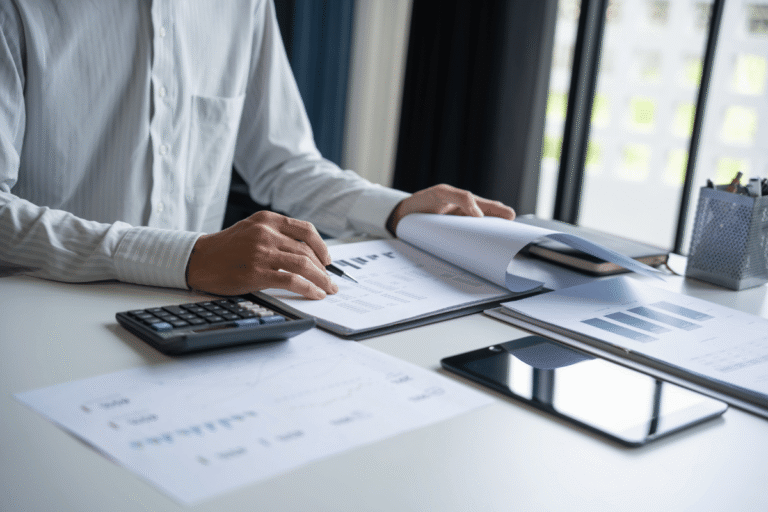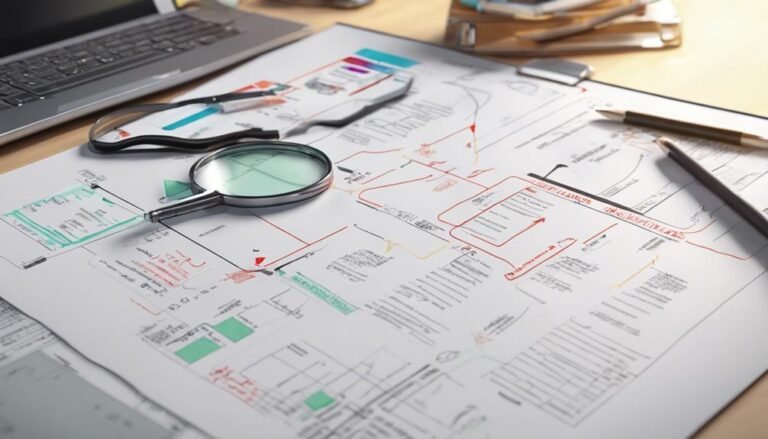Depreciation Methods: Calculating Asset Depreciation
When calculating asset depreciation, you must choose a method carefully. Different methods impact cost allocation, tax implications, and financial reporting alignment. The Straight-Line Depreciation Method spreads out the cost evenly over an asset's life. The Double-Declining Balance Method accelerates depreciation, showing higher expenses initially. The Units of Production Method bases depreciation on asset usage. The Sum-of-the-Years' Digits Method is systematic and accelerates depreciation. Choosing the right method can greatly affect your financial outcomes. Each method offers unique advantages and considerations. Explore further to understand how these methods can best serve your asset management needs.
Key Takeaways
- Straight-Line, Double-Declining Balance, Units of Production, and Sum-of-the-Years' Digits are common depreciation methods.
- Straight-Line evenly distributes depreciation expense over an asset's useful life.
- Double-Declining Balance accelerates depreciation, reflecting higher expenses in early years.
- Units of Production links depreciation to asset usage, ideal for production-based assets.
- Sum-of-the-Years' Digits accelerates depreciation, emphasizing higher expenses in initial years.
Importance of Depreciation Methods
Understanding the significance of depreciation methods is essential for effectively managing asset value over time. Depreciation methods not only impact how the cost of an asset is allocated over its useful life but also have implications for tax and financial reporting.
When it comes to tax implications, the choice of depreciation method can affect the amount of depreciation expense recognized each year, consequently impacting taxable income. Different methods may offer varying levels of tax deductions, influencing the cash flow of a business.
Additionally, the depreciation method selected can also have financial reporting implications. For instance, accelerated depreciation methods may result in higher depreciation expenses initially, leading to lower reported profits. This could be advantageous for reducing tax liabilities but might also give the impression of decreased profitability to stakeholders.
Therefore, selecting an appropriate depreciation method is important for aligning tax strategies with financial reporting goals.
Straight-Line Depreciation Method
The Straight-Line Depreciation Method allocates the cost of an asset evenly over its useful life. This method is straightforward and commonly used due to its simplicity. Calculating depreciation expense using this method involves subtracting the asset's salvage value from its initial cost to determine the depreciable amount. Next, you divide the depreciable amount by the asset's useful life in years to get the annual depreciation expense.
When estimating the asset's value using the straight-line method, you assume a constant depreciation amount each year. This allows for easy budgeting and financial planning since the depreciation expense remains consistent annually. However, it's essential to note that this method mightn't accurately reflect an asset's actual depreciation, especially if the asset's value decreases more rapidly in the early years.
Double-Declining Balance Method
When evaluating, it is crucial to weigh the Double-Declining Balance Method's impact. This method accelerates the depreciation of an asset compared to the Straight-Line Method. Recognized for its capacity to front-load depreciation expenses, it appeals to those seeking to show a higher expense in the initial years of an asset's life.
When contrasting the Double-Declining Balance Method with the Straight-Line Method, the efficiency of calculations is noteworthy. By depreciating assets at a quicker rate initially, this method better corresponds with an asset's actual decline in value over time. This strategy can be especially beneficial for assets that rapidly depreciate in the early years.
The financial ramifications of selecting the Double-Declining Balance Method can be substantial. While it may lead to higher depreciation expenses in the early stages, it can also result in tax advantages by lowering taxable income. Nevertheless, it is crucial to ponder the long-term effects of this method on your financial statements.
| Pros | Cons |
|---|---|
| Front-loads depreciation | Higher expenses in early years |
| Aligns with asset's decline | Complexity in calculations |
| Tax benefits | Potential for financial statement impact |
Units of Production Method
In asset depreciation calculations, the Units of Production Method allocates depreciation based on an asset's usage rather than time. This method is particularly important for assets whose value is determined by how much they're used in production. By linking depreciation to production volume, the Units of Production Method provides a more accurate reflection of an asset's wear and tear.
To apply this method, you first determine the asset's total production capacity over its useful life. Next, calculate the depreciation per unit of production by dividing the asset's cost minus its salvage value by the total number of units it can produce. Then, multiply the depreciation per unit by the actual production volume for the period to find the depreciation expense.
Asset usage plays an important role in depreciation calculations with the Units of Production Method. By tracking production levels and correlating them with depreciation, businesses can more precisely account for asset value changes over time.
Sum-of-the-Years' Digits Method
When calculating asset depreciation, the Sum-of-the-Years' Digits Method offers a systematic approach that considers both the asset's cost and useful life. This method falls under accelerated depreciation techniques, allowing for a larger depreciation expense in the earlier years of an asset's life.
To apply the Sum-of-the-Years' Digits Method, you first need to calculate the depreciable base, which is the asset's cost minus its salvage value. Next, determine the asset's useful life in years. The calculating formula for this method involves adding the digits representing each year of the asset's useful life.
For instance, if an asset has a useful life of 5 years, the sum of the digits would be 5 + 4 + 3 + 2 + 1 = 15. To calculate the depreciation expense for each year, allocate this sum to each year of the asset's useful life. The depreciation expense for a specific year is calculated as (Remaining useful life/Sum of the digits) * Depreciable base.
This method results in higher depreciation expenses in the earlier years, reflecting the asset's decreasing productivity and value over time.
Conclusion
In summary, when it comes to calculating asset depreciation, it's important to understand the various methods available.
Whether you choose the Straight-Line, Double-Declining Balance, Units of Production, or Sum-of-the-Years' Digits method, each approach plays a significant role in determining the value of your assets over time.
By utilizing these methods effectively, you can guarantee accurate financial reporting and make informed decisions for your business's future growth.








